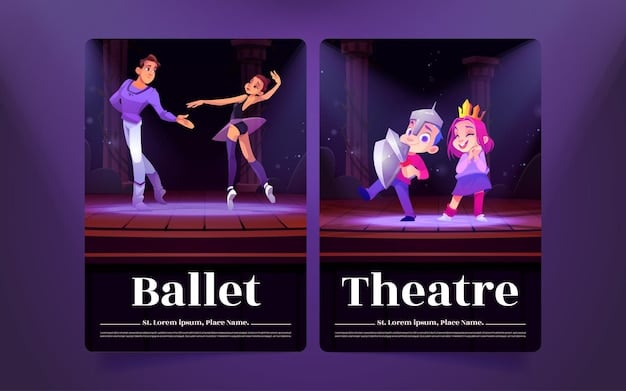From Page to Screen: A Critical Comparison of Adaptations

From Page to Screen: A Critical Comparison of the explores the various challenges and successes in adapting literary works into visual media, highlighting differences in storytelling, character portrayal, and overall impact.
The allure of seeing cherished books come to life on television and film is undeniable. However, the process of adapting a novel or short story into a visual medium like a TV series is fraught with challenges and often results in significant alterations. Join us as we embark on From Page to Screen: A Critical Comparison of the adaptations we love… and sometimes love to hate.
The Essence of Adaptation: Staying True vs. Creative License
Adapting a book into a TV series requires a delicate balance. Should the adaptation remain completely faithful to the source material, or is creative license necessary to make the story work on screen? The answer is rarely straightforward, and the best adaptations often find a way to honor the spirit of the book while still taking advantage of the unique possibilities of the visual medium.
The Pitfalls of Literal Adaptation
Sticking too closely to the source material can sometimes be detrimental. What works on the page might not translate well to the screen. Internal monologues, intricate descriptions, and complex narrative structures often need to be streamlined or re-imagined for a visual audience. A literal adaptation can end up feeling clunky, slow-paced, and lacking in the dynamism that makes for compelling television.
The Allure of Creative Interpretation
On the other hand, too much deviation from the source material can alienate fans and undermine the core themes of the story. When adaptations stray too far, they risk losing the essence of what made the book so beloved in the first place. It’s a tightrope walk, and finding the sweet spot between faithful recreation and creative interpretation is key to a successful page-to-screen adaptation.
- Thematic resonance: Ensuring the core themes of the book are preserved.
- Character fidelity: Maintaining the essence of the main characters.
- Plot coherence: Making sure the storyline makes sense visually.
- Engaging visuals: Using the visual medium to enhance the story.
Ultimately, the success of an adaptation hinges on its ability to capture the heart of the original work while crafting a compelling and engaging viewing experience. It’s about understanding what elements are essential and what can be reimagined to best serve the new medium. This balance between fidelity and freedom is what frequently determines whether an adaptation will be celebrated or scorned by fans and critics alike.

Character Transformations: From Imagination to Performance
One of the biggest challenges in adapting a book into a TV series is bringing the characters to life. Readers often have very specific ideas about how characters look, sound, and behave. Casting choices and performances can either delight or disappoint, depending on how well they align with these pre-conceived notions.
The Actor’s Burden: Meeting Expectations
Actors face immense pressure when taking on roles based on beloved literary characters. They must embody the physical attributes and personality traits described in the book, while also bringing their own unique interpretations to the role. It’s a delicate balancing act, and success often depends on the actor’s ability to capture the essence of the character while also making it their own.
The Author’s Vision vs. the Screenwriter’s Interpretation
Sometimes, changes to a character are necessary for the sake of the adaptation. A character that works well on the page might not be as compelling on screen, or their role in the story might need to be altered to fit the demands of the visual medium. These changes can be controversial, but they are often made with the intention of enhancing the overall viewing experience.
- Physical Appearance: How closely the actor matches the character’s description.
- Personality Traits: Capturing the character’s core personality and quirks.
- Emotional Range: Portraying the character’s emotional journey authentically.
- Impact on the Narrative: How the character’s role is adapted for the screen.
The transformation of characters from page to screen is a complex process that requires careful consideration and skillful execution. It’s about finding the right actors, understanding the nuances of the characters, and making the necessary adjustments to ensure that they are as compelling and believable on screen as they are in the book. When done well, these character transformations can elevate the adaptation and create a truly memorable viewing experience. However, missteps in this area can lead to disappointment and criticism from fans.
Plot Twists and Turns: Adapting Narrative Structure
The narrative structure of a book and a TV series can be vastly different. A novel might unfold at a leisurely pace, delving into intricate subplots and character backstories. A TV series, on the other hand, often requires a more streamlined and episodic structure to keep viewers engaged week after week.
The Art of Condensation
One of the biggest challenges in adapting a book is condensing the plot into a manageable number of episodes. This often involves cutting out subplots, merging characters, and streamlining timelines. While these changes can be frustrating for fans of the book, they are often necessary to keep the story moving at a reasonable pace.
The Power of Visual Storytelling
TV series have the advantage of visual storytelling. They can use images, sound, and music to convey information and emotions in a way that books cannot. A skilled screenwriter can use these tools to enhance the impact of the story and to create a more immersive viewing experience.
Adapting narrative structure involves making strategic decisions about what to keep, what to cut, and what to reimagine. It’s about understanding the strengths and limitations of both the source material and the visual medium, and finding the best way to tell the story in a compelling and engaging way. While some changes may be controversial, they are often necessary to ensure that the adaptation works as a TV series.

Setting the Scene: Visualizing Imagined Worlds
Books often allow readers to conjure imagined worlds, vividly depicting landscapes, interiors, and atmospheres. A television series must physically construct these worlds, making choices in set design, costume, and cinematography that either stay true to the text or offer a different interpretation.
The Impact of Location and Design
The selection of filming locations or the construction of sets can significantly influence the audience’s perception of a story. A faithful adaptation seeks to mirror the described environment, enhancing the narrative’s authenticity. Divergences, however, can offer unique perspectives or modernize the setting for a contemporary audience.
Costume as Character
Costumes do more than clothe actors; they are extensions of character, implying social status, emotional state, and personal history. How closely these visual cues adhere to the book’s descriptions can shape viewer interpretation and connection to the characters.
- Geographical Authenticity: Accuracy in representing locations.
- Atmospheric Consistency: Maintaining the mood described in the book.
- Technological Integration: Incorporating necessary modern elements thoughtfully.
- Cultural Sensitivity: Respecting and accurately portraying cultural elements.
The transition of setting from page to screen involves critical decisions that affect narrative credibility and viewer engagement. Balancing faithfulness with creative interpretation allows adaptations to build worlds that are both recognizable and visually enriching.
Themes and Messages: Preserving the Core
A successful adaptation not only tells the same story but also resonates with the same underlying themes and messages as the original book. This can be a challenge when adapting complex or nuanced works, but it is essential for capturing the essence of the story.
Navigating Moral Ambiguity
Many books explore complex moral issues and present characters with conflicting motivations. Adapting these themes for the screen requires a delicate touch, as it is easy to simplify or distort the original message. The best adaptations find ways to preserve the ambiguity and complexity of the source material, allowing viewers to grapple with the same questions and dilemmas as the characters.
- Faithful Representation: Reflecting key themes accurately.
- Nuanced Character Portrayal: Maintaining complexities.
- Social Commentary: Addressing original social issues.
- Ethical Dilemmas: Presenting moral questions.
The Risk of Oversimplification
There is a risk that adaptations will oversimplify the themes and messages of the book, either to make the story more accessible or to cater to a wider audience. However, this can undermine the integrity of the original work and leave viewers feeling unsatisfied.
Adapting themes and messages involves a deep understanding of the source material and a commitment to preserving its intellectual and emotional depth. It requires careful consideration of how these themes will resonate with a visual audience, and a willingness to take risks in order to stay true to the original vision.
Fan Reception and Critical Acclaim: Measuring Success
Ultimately, the success of a page-to-screen adaptation is measured by how well it is received by fans and critics. A faithful adaptation may be praised for its accuracy, but it may also be criticized for lacking originality. A more creative adaptation may be praised for its innovation, but it may also be criticized for straying too far from the source material.
The Power of Nostalgia
Nostalgia can be a powerful factor in shaping fan reception. Viewers who have a strong emotional connection to the book may be more likely to appreciate an adaptation that stays true to the source material, even if it is not perfect. However, nostalgia can also lead to unrealistic expectations and disappointment when the adaptation fails to live up to cherished memories.
The Importance of Originality
While faithfulness is important, originality is also a key ingredient for a successful adaptation. Viewers want to see something new and exciting, not just a carbon copy of the book. The best adaptations find ways to add their own unique spin to the story, while still staying true to the spirit of the original work.
Measuring success involves balancing faithfulness with originality, managing expectations, and understanding the power of nostalgia. It requires a deep understanding of the source material and a willingness to take risks in order to create a viewing experience that is both satisfying for fans and critically acclaimed.
| Key Element | Brief Description |
|---|---|
| 🎬 Adaptation Fidelity | Staying true to the source material vs. taking creative liberties. |
| 👤 Character Portrayal | Actor performance and character’s embodiment. |
| 🗺️ Visual Setting | How imagined worlds are brought to life visually. |
| 📜 Thematic Integrity | Preserving key themes and messages. |
Frequently Asked Questions
▼
A successful adaptation balances faithfulness to the source material with creative interpretation, honoring the original’s spirit while enhancing the viewing experience. Key aspects include capturing core themes and bringing compelling characters to life.
▼
Adaptations often change or cut plot elements for pacing. Some fans prefer strict adaptations, while others accept alterations. Changes should enhance the visual story, avoiding critical original themes.
▼
Actors are crucial in bringing characters to life. They must embody character traits while adding their interpretation, impacting audience connection and perception. The right casting improves the adaptation.
▼
TV series often streamline or cut plot elements for pacing. Visual storytelling adds depth. Successful adaptations balance the book’s integrity with the series structure for an engaging story.
▼
Fan reactions depend on nostalgia, how well key themes are depicted, and originality. Adaptations that add unique elements and honor the source material are more likely to be celebrated.
Conclusion
In conclusion, adapting books into television series is a multifaceted endeavor that requires a delicate balance between fidelity and creativity. Whether adapting settings, characters, or storylines, each decision impacts the adaptation’s narrative integrity and viewers’ experience. The finest adaptations honor the original’s spirit while crafting a compelling, individual visual journey.





